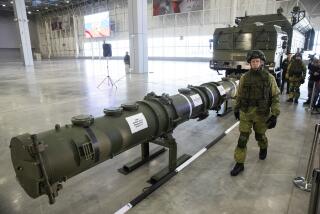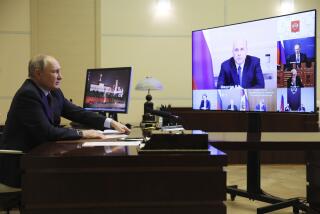Back to the Test Ban
The Reagan Administration’s negative response to the Kremlin’s renewed call for a nuclear-test moratorium would make a certain amount of sense if it were tied to a realistic strategy for nuclear-arms reduction. Unfortunately, it isn’t.
Soviet leader Mikhail S. Gorbachev announced this week that Russia’s year-old moratorium on nuclear testing was being extended to next Jan. 1. He again invited the United States to join in the moratorium, which he said could be transformed into a permanent agreement at a summit meeting with President Reagan.
Washington quickly rejected the Gorbachev proposal as just another “propaganda ploy” aimed at putting the United States on the defensive in the strategic arms reduction talks and in a prospective summit meeting late this year.
Skepticism about a moratorium is warranted. A stop-where-you-are moratorium would leave one side or the other feeling disadvantaged and compelled to break out of the agreement. There are real questions of compliance and verification. So a test ban cannot simply be declared; it must be negotiated. The need is not for a moratorium but for a permanent, enforceable treaty. But Reagan still has not accepted the advisability of such an agreement.
The Administration’s bottom-line goal is to bring about a reduction in the Soviet armada of offensive missiles--especially the multiple-warhead giants that are regarded as particularly threatening to the U.S. nuclear deterrent. The Soviets, who completed an important test series shortly before declaring their moratorium, are seen as wanting to head off the U.S. missile modernization program and to stop Reagan’s Strategic Defense Initiative without having to negotiate cuts in their own nuclear arsenal. That isn’t acceptable.
Common sense says that a test ban should be negotiated in parallel or tandem with a mutual reduction in offensive nuclear forces. But the Soviets are not interested in such a reduction unless they can get some restraints on Reagan’s strategic defense program. And the President is still hanging back from that kind of deal.
The fact is that the Administration wants to continue testing in order to confirm the reliability of nuclear weapons already in the inventory and to test the effects of nuclear explosions on communications and other equipment. The Administration also does not want to foreclose the development of “Star Wars” systems making use of nuclear explosions in space.
The national laboratories argue that continued testing is advisable to develop ever smaller and less destructive nuclear weapons. And they point out that the Soviets could keep their nuclear laboratories operating full blast with a test ban in effect, while ours would atrophy.
Some of these arguments, including the Star Wars nuclear option, should be dismissed out of hand. Others merit respect. But, on balance, a nuclear ban is attractive because it would tend to slow the technological competition in nuclear arms, leading to less emphasis on such weapons.
The arguments against joining an unenforceable, potentially destabilizing nuclear-test moratorium are persuasive. But the Administration should stop stonewalling on the negotiability of restraints on Star Wars, and begin to negotiate seriously toward an arms-reduction agreement and a verifiable test-ban treaty.
More to Read
Sign up for Essential California
The most important California stories and recommendations in your inbox every morning.
You may occasionally receive promotional content from the Los Angeles Times.









